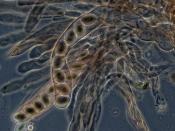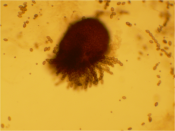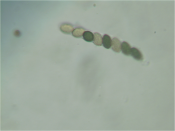Carrie Miller October 22, 2001 BioS221 MW 11am SORDARIA FIMICOLA Introduction: In this lab we will be exploring the linkage and crossing of ascosporic color in Sordaria by using tetrad analysis. "Strains of Sordaria have different colored ascospores, a heritable trait in which the alleles are found at the same locus and inherited in typical Mendelian dominance-recessiveness." (Thompson, 1) Throughout the lab we will keep in mind the Mendelian principle.
Sordaria is an ascomycete fungus that "spends most of its life cycle in a haploid vegetative state. However, under certain conditions, two haploid strains can be induced to undergo a sexual process in which they fuse to form diploid zygotes."ÃÂ (Mertens,141) After asgonia appears on hyphae meiosis occurs, creating haploid ascospores contained in a linear order in sacs called ascus (asci). Recombination occurs forming the tetrad product of meiosis. Eight ascospores with different recombinants are then produced through mitosis. (handout) By analyzing these spore patterns one can observe crossover events that occurred during meiosis when an allelic marker is located on each chromatid of a synapsed tetrad.
Through this analysis, important pieces of information can be discovered. First, one can determine which two of the four chromatids participated in the cross over event. Secondly, the frequency of the different types of asci and the crossover percent can be calculated. And also the gene can be mapped in relation to its centromere.
Methods: First, the two strains (wild type and a mutant) need to be cultured. The two different strains of Sordaria should be inoculated onto a growth medium consisting of cornmeal agar and glucose-yeast extract for about 72 hours before starting the crosses. These were grown at 25 to 28 degrees Celsius in a humid environment. (handout) Sexual reproduction has now occurred, producing "black fruiting bodies called perithecia." (Mertens,142) Next,


